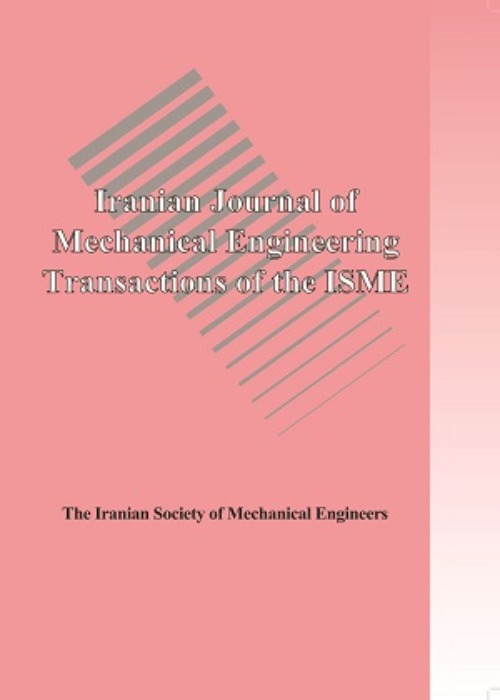فهرست مطالب
Iranian Journal of Mechanical Engineering Transactions of ISME
Volume:13 Issue: 1, Mar 2012
- تاریخ انتشار: 1391/11/01
- تعداد عناوین: 7
-
-
Using Weibull Probability Distribution to Calibrate Prevailing Wind Applying in Oil Spill SimulationPages 5-22In the Persian Gulf, the major source of oil pollution is related to the transportation of tankers, offshore production and discharges by coastal refineries. The water dynamical field has been obtained using a new hydrodynamic model. Local wind is recognized as the principal driving force combining to the water dynamic field to determine oil drift on the sea surface. The Weibull probability distribution is considered to adjust the prevailing wind obtaining by data from measurements and compared with other data, displaying fairly good conformity. To model the advection and dispersion in the Persian Gulf which is a shallow water area, random walk technique has been used. Comparison of the actual and simulated oil spill trajectory based on real wind field was found acceptable in the Iranian waters.Keywords: Weibull distribution, Probability wind field, oil spill modeling, Persian Gulf
-
Pages 23-35In this paper, an upper bound approach is used to analyze the extrusion process of bimetallic rods through arbitrarily curved dies. Based on a spherical velocity field, internal, shearing and frictional power terms are calculated. The developed upper bound solution is used for calculating the extrusion force for two types of die shapes: a conical die as a linear die profile and a streamlined die shape as a curved die profile. The bimetallic rod extrusion process is also simulated by using the finite element code, ABAQUS for those two die shapes. The analytical results have been compared with finite element data and the experimental results obtained from a reference to illustrate the validity of the proposed upper bound solution. These comparisons show a good agreementKeywords: Bimetallic rod, Extrusion, Upper bound
-
Pages 36-51This paper investigates the application of Artificial Bee Colony (ABC) method for the optimization of Tuned Mass Dampers (TMDs) employed for high-rise structures including Soil Structure Interaction (SSI). The model is a 40-story building, and Newmark method is utilized for the structure response to Bam earthquake data. The objective is to decrease both maximum displacement and acceleration. It is shown that ABC method can be effectively applied to design the optimum TMD for tall buildings. It is also indicated that this model is more accurate than fixed based models. The effects of mass, damping coefficient and spring stiffness are also studied. This study leads the researchers to the better understanding and designing of TMDs for the mitigation of earthquake oscillations.Keywords: Tuned Mass Damper, Soil, Structure Interaction, Bee Colony Optimization
-
Pages 52-67Gas holdup and bubble size are important parameters for simulation and designing in bubble column reactors. Because based on these parameters, the available gas-liquid interfacial area is defined for mass transfer. In this paper, the results of applying magnetic fields on the velocity field and volume fraction of gas holdup are reported. Hydrodynamics of the bubble column in the reactors is investigated numerically using Euler-Euler model, standard k-ε turbulence model considering axisymmetric assumption, and the control volume technique. The results show that the magnetic fields have minor effects on increasing the volume fraction of gas holdup, but it causes to change in the flow field and vortex. In addition, effects of other parameters as well as rotation of the fluid, bubble size, and variation of inlet velocity on the volume fraction of gas holdup have been presentedKeywords: Gas holdup, Magnetic field, Velocity field, Bubble size, Euler, Euler model
-
Pages 68-87The purpose of this study is to design an intelligent control system to guide the overtaking maneuver with a higher performance than the existing systems. Unlike the existing models which consider constant values for some of the effective variables of this behavior, in this paper, a neural network model is designed based on the real overtaking data using instantaneous values for variables. A fuzzy controller is then designed to present trajectory of the overtaking vehicle. Validation of the proposed controller is done by comparing the responses of the controller with the behavior of human drivers. Results show that the controller system intelligently performs like a human driver and also eliminates their mistakes and sudden moves.Keywords: Overtaking Maneuver, Autonomous Vehicle, Neural Network, Fuzzy Controller
-
Pages 88-103This article utilizes the average stress method to obtain the stress in- tensity factor of rotating solid and hollow disks/cylinders containing a radial crack. It is assumed that the cracks are located radially at center, internal or external radius of the geometry. Results are shown for both of the plane stress and plane strain assumptions and are val- idated against the known data introduced in the literature searchKeywords: Stress intensity factor, Small crack, Rotating disk, cylinder, Radial crack, Axial crack


